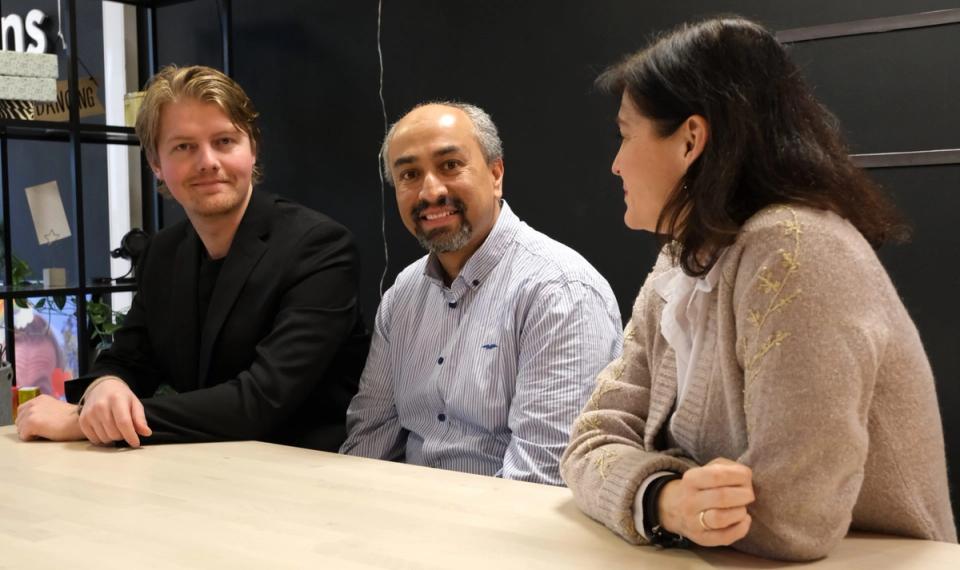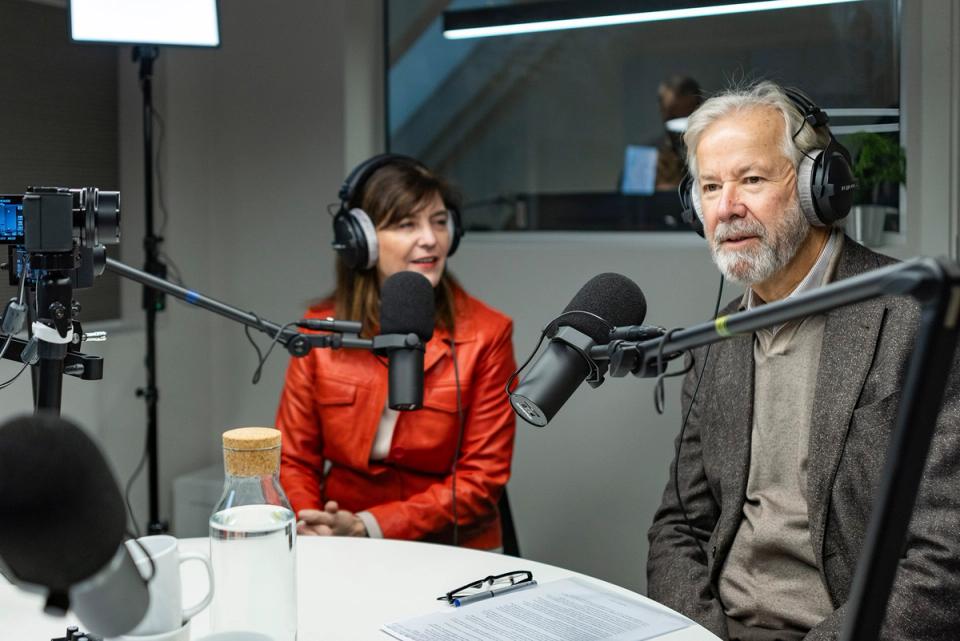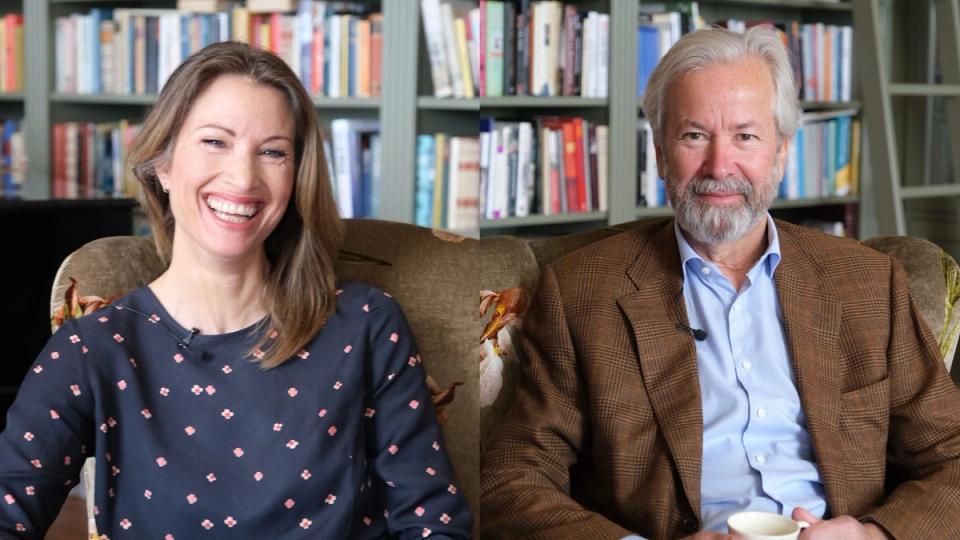2. juli 2019
Blockchain-based journalism

Walid Al-Saqaf and Simen Reynolds agree that journalists need to test and use blockchain technology. Here’s their best advice on how […]
Walid Al-Saqaf and Simen Reynolds agree that journalists need to test and use blockchain technology. Here’s their best advice on how to start and who to look to for inspiration.
In our latest podcast we dig deeper into blockchain technology and journalism. Kjersti Løken Stavrum, CEO of the Tinius Trust, talks to Walid Al-Saqaf, senior lecturer at Södertörn University, and Simen Reynolds, business developer in Blockchangers, about what blockchain can do for journalism.
Listen to the episode below or find Tinius Talks in your favorite podcast application, for instance iTunes, Spotify or SoundCloud.
Below you can read a full transcript of this episode.
Kjersti: Welcome to the Tinius Talks, the podcast on media business at large from the Tinius Trust.
(Jingle)
Kjersti: This time we will do it in English, because we have prominent, foreign English-speaking guests.
Walid Al-Saqaf, you are a senior lecturer at Södertörn University outside Stockholm, and you work within media, technology, journalism, internet and blockchain research. And that is what we are going to talk about today, the last part of it: Blockchain.
And to talk and discuss with you we have invited Simen Reynolds. And you are business developer and solutions architect in Blockchangers, which is a company that obviously works a lot with Blockchain. Welcome to you too! I’ve also heard you being presented as a rockstar within blockchain.
Simen: I wouldn’t call myself a rockstar. I’m more just a nerd who stumbled into this.
Kjersti: So, you dug yourself into blockchain voluntarily?
Simen: Yes, I did.
Kjersti: Walid, if we take this from the journalistic part of it. Who uses blockchain within journalism these days? Do you have any current and interesting examples?
Walid: The most popular blockchain we have is steemit.com. Steemit is basically taking into spirit the blockchain space proving that it is well be possible to have a database that is distributed and contains journalistic content. Not necessarily all content is journalistic, just like any other social media platform. There are some of them that are journalistic, and some are not.
There is also another project called civil.co and one of their ambitions is to develop a model based on crypto economics. The underlying promise of it is that you use their own token (explanation) called CVL which is basically a token that is built on top of Ethereum (explanation) to incentivize members of the Civil network to act upon, in terms of approving, voting against or validating journalistic content, to remove disruptive and poor quality content and improve the overall quality and hopefully turning journalism into a profession that many can be proud of again. So, it’s quite ambitious and it’s still has its own stumbling stones and a way to go. For example, they’ve launched their own ICO (explanation) and it didn’t do well, unfortunately, and later they realized that there is still more work to do.
Kjersti: I’ve heard startups presenting that idea before, so to say. So Simen, do journalism need blockchain?
Simen: I think in storage, stopping censorship, making sure people are accountable for what they publish, that they get the rights for what they publish, and that something can’t be taken down – all these are important things for journalism.
Kjersti: You didn’t really mention the trust part of it. That things are supposed to be very safe and true on Blockchain. And that was where the discussion on blockchain started, wasn’t it, Walid?
Walid: Indeed. One of the major promises that is introduced by blockchain technology is to allow provenance (explanation), meaning that you are able to track original content the moment its developed or created.
Walid: The idea behind some project, such as truepic.com which is more of a startup in the US that’s been verifying authentic imagery at the beginning.
It started with insurance. Let’s say you have an accident and your car has been damaged, and so the one way you can verify that the damage really happened on the spot at that instant is to bring in an officer from the insurance company. But the company ended up developing an app that could actually add geolocation (explanation) and metadata about the image when you take a photo to verify the authenticity and the information around where and when it was taken, and then upload this to the blockchain, meaning that its now in an imputable record somewhere that can be verifiable.
So, they ended up thinking maybe just as it is useful to document car crashes, why can’t it also document real original media and news content? Let’s say an incident in Syria that took place or perhaps a fire that broke up.
One of the proposals was to look back in time and see the original videos release date and the authenticity of the creator of this data. If that’s on the blockchain it is likely that the next version is not the real version. It is the original version that was there to start with. So, this is another way in which you can help mitigate fake news.
Kjersti: Do you also think, Simen, that video content… that we can sort of strangle deep fake in the beginning now with blockchain?
Simen: Deep fake (explanation) is an example of using machine learning technology to fake visual content.
And so, adding for instance geolocation or specific tracking pixels in video content to make sure that something is from a specific source, works only to the extent that the people publishing content wants to be genuine.
So, for instance, you can make an algorithm that will fake geolocation. But you can’t fake provenance, so if your video if on the blockchain or if a record of that video is being uploaded somewhere is on the blockchain – that you can’t fake. But someone can alter a video enough that most software won’t be able to link the altered video to the old video. If someone is doing it on purpose, then it becomes hard. But it can help you stop when people spread something that they don’t know is fake, or that they have been misinformed. But when someone tries to fool you, then it’s a lot more difficult. Provenance is probably the safest thing we know.
Kjersti: Well, I regret asking you anyway. I think this is the story on blockchain. We hope and we need some trustworthy tools, things that can help us build true stuff and then blockchain was for some time the answer. But now it’s also been hacked, Walid?
Walid: First, let us define the word hacked. There are a few misconceptions about what hacked means. Whenever your money at a particular exchange is taken away because of a hack, it’s not because the blockchain itself was hacked. But those who use your private key (explanation), which is the way you can prove you’re the owner of a particular amount of crypto currency, they have for example carelessly stored the data in such a way that leads to the data being stolen. That’s not on the blockchain itself, but it’s in a central database.
So basically, we are repeating the same problem that blockchain wanted to solve, which is centralization of data.
What needs to happen is that every single individual that owns a form of crypto currency on a blockchain needs to maintain and secure that private key, and not give it away to a central authority. Otherwise it can be hacked.
But there is also another form of hacking, and this happens on the client-end. For example, if you have a wallet on your computer or on your mobile phone, that information can also be jeopardized.
There is also a third form of hacking, which is closest to what might be considered as a hacking of the actual blockchain, which is called the 51 % attack.
Kjersti: It is so then… Because you touched upon decentralization of information. And my question then is: To be sure you have to be a part of the motorway within blockchain so to say, you have to be one of the big guys, how decentralized is it then?
Simen: The mining or production (if you could call it that) of blockchain, fluctuates in the entire world. But there is one province in China that has a couple of times controlled about 50 % of the world production of bitcoin. That could potentially be a problem because if those went together and for some reason with some incentives and maybe with government backing wanted to do a 51 % attack, they theoretically could.
Kjersti: I would say that they are pretty close to it if they already have 50 %.
Simen: So, they don’t always have it because of the way Bitcoin is built, but yes. If they do a 51 % attack, that would be bad. But there is something in blockchain called a fork. Basically, it means that some part of the network decides that no, we degree with what happened here, we will make our own blockchain and we will omit the results from this part of production facility of bitcoins for instance.
So, if they did a 51 % attack you could theoretically see almost instantly within minutes someone that would set up another chain based on the previous bitcoin blockchain that would continue without that influence. So, if someone attacks, they have to attack without people knowing, because if people know they will instantly try to fix it.
And it is decentralized. The storage… even though the production might be centralized because of this, the storage of the ledger is spread out everywhere. The information is decentralized, the production is maybe not.
Kjersti: Let’s say it is decentralized. That I was wrong in my previous question. How can people get access to this centralized information? One thing is that you store it, but how to secure access for all people to this decentralized information, Walid?
Walid: That’s an excellent point. It’s one of the dilemmas of the usability of the technology. It’s not going to be easily adapted by the masses until the layer between the regular user and the blockchain becomes easier to use and facilitated. What we have now is what we call wallets (explanation) and wallets are basically your interface. You have to communicate with the blockchain using software, and this software is put in a neat way to become a form that would allow anyone, even my grandmother, to be able to “grandma friendly” have anyone use the blockchain for various purposes.
The other flipside to it is that there is a compromise, and I think it applies to many areas.
If you want it to be more user-friendly, you have to give more trust to the custodians who will be taking your private key and using them or using their own server to store the blockchain instead of your device being the node. So, there is always going to be a compromise between one and the other.
Kjersti: OK. Walid says that we should get our self a wallet. But how do you put things on the blockchain?
Simen: Maybe the easiest way to get into blockchain and to start interacting with the blockchain is to use something called metamask.io. It’s a plug-in for Chrome and you can use it to interact with the Ethereum blockchain. And you can also use it to create an account on something called ROPSTEN. It’s like the Ethereum blockchain, but for test users. You can get free Ethereum and you can transfer to wallets. And it’s not worth anything, it’s just for testing purposes, but you can test out the ID-solutions, signing and so on.
(Jingle)
Kjersti: Lets wind fast forward. Let’s say that blockchain is a lot more customized today. If you were a journalist then, how would you deal with blockchain in your everyday life when you collect information, when you do research… How to implement blockchain in that process?
Simen: In my ideal world I would write an article, maybe even a draft. And I would upload what’s called a hashed version of that to the blockchain. It’s basically a version that is unique but can be read by anyone else. I would go and have it published somewhere. Preferable that publishing platform would also be integrated with blockchain so whenever some sort of revenue came from that… I will try not to be to technical, but basically blockchain enables small program to run of the chain itself.
If someone paid for a subscription and viewed an article, the program could automatically send me the six cents or whatever that I had technically earned for that article.
And if someone tried to say no, this isn’t you article I wrote that, I would then say no, look, here is the address and the hash of my article that only I could read. And I would release the key to show that I actually wrote that. Being able to do something like that, I think would be massive for not just journalism, but content in general.
Kjersti: But for me as a reader or watcher of your content then, would I notice any difference when I consume the content?
Simen: That depends on how well things are created. For instance, right now there is a project called brave.com. It’s a web browser. You essentially go around the Internet and instead of you paying for specific services in different places, Brave tracks what you visit and they you pay Brave a certain amount each month (however much you want) and it distributes that on the people you think deserve it. And the same interface could be used on a newspaper’s website. Where you just log in with your account. You would log in, you would be on articles, you would say I like this one, and it would automatically say because you like this one take 16 % of his subscription and send it to that article. And if that article was a joint work between to reporters, that smart contract would easily say they get 8 % each or this person had the photo, so he gets 5 % and this person wrote the script, so he gets 6 %.
Kjersti: I would feel much better reading it then.
Simen: You would feel better and you wouldn’t necessarily have to interact with it at all.
If you were a non-technical person, you could just read the article, and all the financing and transfers would happen in the background preferably without you even noticing.
Kjersti: Walid, you used to be Editor-in-Chief and publisher of Yemen’s first English language newspaper Yemen Times. Then, I guess you didn’t use blockchain in you work. Did you wish you’d done that?
Walid: Well. You’d never expect something like this to happen. Technology changes rapidly.
I wouldn’t have dreamt that there would be a possibility for someone to have impressions and leads of a particular article being already calculated for and then sent, even micro transactions, instantly sent to my account. Obviously not.
I realize that the Internet itself was similar in its birth. It disrupted something. The Internet disrupted the way we communicated. It was a rough ride, because eventually the competition was very intense by those producing content from across the globe from various social media etc.
So now we have another opportunity. We are given a chance to see.
There is another disruptive technology called Blockchain, and we as journalists are spectating. Will we be active in understanding how it works and how we can benefit from it, or will we just say on the sidelines? I would argue for the former.
It’s important that we understand that new technology, disruptive technologies, can have an impact on all walks of life.
Kjersti: If you should give advice to a young journalist to approach blockchain, how would you recommend that she did it?
Walid: Try, get a wallet and being learning. It always starts with doing. I’ve never really learned something deep inside how it works until I began working on it. Because you can hear a lot, you can read a lot, but until you get a wallet running, until you get some sort of extension or plug-in or get to demonstrate that you send someone a transaction, until you do that you can’t really know how it feels.
Kjersti: Simen, you presented yourself as a nerd. Most of us are not. But what would your recommendations be for… well, let’s say you are an ordinary journalist. How should you start working with blockchain?
Simen: Civil is a good example, because they have a lot of professional journalists that actually sat down and said how can we use this and how can we make things easier. It is very much about platforms and momentum.
If some blockchain project seems like it could help your day to day life, don’t report on it and then leave it. You have to interact with it, use it and test it. The more mature a platform becomes the easier it is to go on and say ah ok, but it’s really the early adopters that are the most important.
Also, when I speak about blockchain many people perceive me as very negative, because I talk about security risks and so on. But it’s not because the blockchain is a bad thing. But a lot of people have hyped it up into something that it’s not. Like you said earlier, it’s very much a tool in the toolbox. Somethings can only be done on blockchain and some things should never be done on blockchain.
So, keep in mind if someone tries to give you a solution for something you already have a solution for. That’s not really a solution. It’s trying to fit a tool to a problem.
Kjersti: Do you agree to that, Walid? I think much journalism is about perspectives, right? Opinions and perspectives and how I see things. Blockchain doesn’t really apply to that.
Walid: I’d say there is always something to everyone when it comes to details. We cannot dismiss the whole thing and say we cannot relate or say fully that we can’t live without this. There needs to be a balance of opinion. It needs to be subject to understanding what exactly you are trying to solve, and where in the blockchain is there some characteristic that helps you.
I’d say for example in the Civil-case, it’s important for us to understand that there are various characteristics on the blockchain. Some of them are applicable to journalism, for example the idea of provenance, finding and tracking, but others may not be.
The idea of immutability, you can keep a secure record, but making the record immutable to the extent that it is impossible to erase over time… There are questions regarding that. Some people consider it important to have the opportunity to edit, to change, to remove. So, it’s important to see this as an opportunity to enhance in journalism and beyond. And not to forget that we are in a stage where technology is advancing extremely rapidly.
Just the other day I tried to participate in what is called the Lightning Network Trust Chain. You may have heard of it. Basically it is passing a torch (explanation) from one person to the other using payments. We realized that this can actually help against censorship. We are in this phase of trying to convince some of the nodes to send one of the payments to a fellow in Iran and the idea was to ensure that this is a message saying ok, we can bypass various forms of censorship using this technology. If it applies to funding, it can also apply to information and it can help in many aspects. So, these disruptive technologies are unpredictable. We need to take one step at a time and learn from them.
Kjersti: Thank you very much. I thought that was a very great finish. Its somewhere between a hype and very promising for core aspects in our democracy, I think.
So, I would like to say thank you to Walid Al-Saqaf, who is a senior Lecturer at Södertörn University outside Stockholm, and Simen Reynolds, who is business developer and solutions architect in the firm Blockchangers. Thank you both of you.
If there are listeners there that are still curious on blockchain, which I think you should be, you should check out https://civil.co and https://steemit.com that has been mentioned in this podcast. Check it out, be inspired, and get yourself a wallet!



